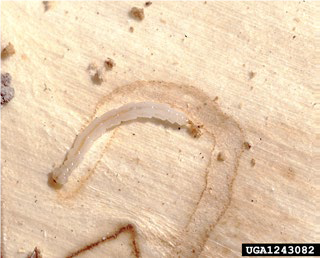The bronze birch borer (Agrilus anxius) is found throughout the birch range in the U.S. and Canada. It attacks and breeds in paper birch, yellow birch, gray birch, western birch, water birch, and sweet birch, and has been found in stands of beech and aspen. Paper and yellow birch are the preferred hosts.

Credit: Dode Gladders, University of New Hampshire Extension.
Description
The larvae of the bronze birch borer are slender, flattened, and have two small spines at the end of their abdomens. They are about 1" long. The adults range in color from deep olive green to bronze. The segment behind their head is a copper color, and the head is greenish in males and copper in females. They range from 3/8” to 1/2” in length.
Life Cycle
In New Hampshire, it takes two years for the bronze birch borer to complete development. Adults begin to emerge in late May - early June and can be found emerging until August. After emerging, the adults feed on leaves for about three weeks. After feeding, they mate, and females deposit eggs singly or in groups in cracks and crevices in the bark, usually on the unshaded areas of trees. Upon hatching, in two weeks, the larvae move just under the bark, forming galleries where they spend the following winter, spring, summer, fall, and a second winter. They emerge as adults the second spring.

Whitney Cranshaw, Colorado State University,
Bugwood.org.
Damage and Diagnostic
The larval stage of this insect is a major pest of the phloem and cambium layer of trees, as its feeding interferes with sap movement within trees. If the bark is removed, serpentine or winding galleries can be found. Once trees are heavily infested with this borer, they have little chance of survival. Bronze birch borers usually attack weakened trees. Key diagnostic features are sawdust packed galleries spiraling around the tree bole or branches, a thin crown, and 3/16" D-shaped exit holes.

Credits: Whitney Cranshaw, Colorado State University,
Bugwood.org.

State University, Bugwood.org.
Management
The best means of management is prevention.
IPM Strategies:
- Cultural - Larvae are reported not to survive in healthy trees. Branches that are completely dead or show damage symptoms should be pruned and destroyed by early May. Proper maintenance of birch trees by pruning, fertilizing, and watering will keep a birch tree vigorous and is the best line of defense.
- Chemical - Consult your county Extension Field Specialist for specific recommendations.
 Stop! Read the label on every pesticide container each time before using the material. Pesticides must be applied only as directed on the label to be in compliance with the law. All pesticides listed in this publication are contingent upon continued registration. Contact the Division of Pesticide Control at (603) 271-3550 to check registration status. Dispose of empty containers safely, according to New Hampshire regulations.
Stop! Read the label on every pesticide container each time before using the material. Pesticides must be applied only as directed on the label to be in compliance with the law. All pesticides listed in this publication are contingent upon continued registration. Contact the Division of Pesticide Control at (603) 271-3550 to check registration status. Dispose of empty containers safely, according to New Hampshire regulations.
Download the resource for the complete factsheet.
